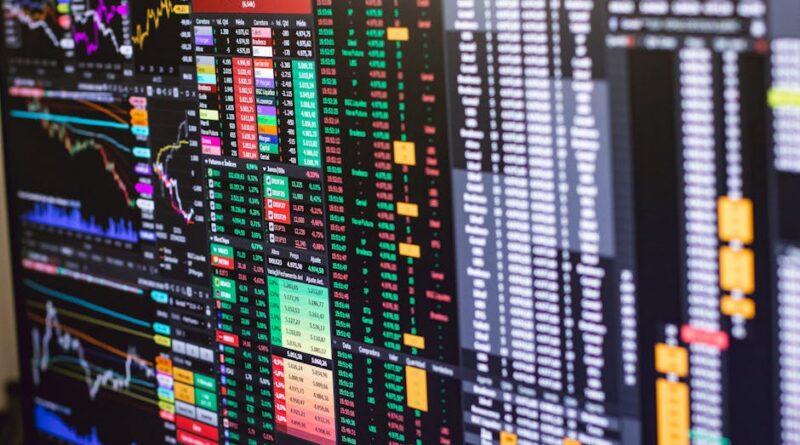Stock Market Selloff Slumps as Dow Drops 500 Points in Tech Rout
U.S. stocks experienced a sharp decline on Thursday as investor concerns over overvalued tech shares and a deteriorating job market triggered a widespread selloff. The Dow Jones Industrial Average fell 507 points, marking a 1.07% drop, while the S&P 500 slid 1.16% and the tech-heavy Nasdaq Composite tumbled 1.84%. This stock market selloff highlights growing unease about the sustainability of recent gains driven by artificial intelligence enthusiasm.
The downturn came after fresh data revealed a surge in layoff announcements, the highest for October since 2003. Challenger, Gray & Christmas reported that planned job cuts accelerated, raising alarms about economic slowdown. Investors shifted toward safer assets like U.S. Treasury bonds, pushing yields lower as expectations build for Federal Reserve rate cuts to support a weakening labor market.
Tech Sector Leads the Charge Downward
Technology and AI-related stocks bore the brunt of the stock market selloff. Advanced Micro Devices (AMD) shares slumped 7%, reflecting broader worries in the semiconductor space. Palantir (PLTR) dropped 5.5%, and Nvidia (NVDA), a bellwether for AI investments, fell 3%. These declines continue a pattern of volatility, with investors questioning whether the AI boom has created a bubble reminiscent of past tech frenzies.
The Nasdaq’s outsized loss underscores the market’s heavy reliance on Big Tech. Despite strong corporate earnings earlier in the year, enthusiasm for AI has waned as valuations stretch to extreme levels. Wall Street’s fear gauge, the VIX, surged 12%, entering territory that signals heightened anxiety. CNN’s Fear and Greed index shifted firmly into "extreme fear," a stark contrast to the optimism that fueled monthly gains through October.
Legendary investor Warren Buffett’s preferred market gauge, the Buffett Indicator, flashed warning signs at over 200%—a record high. This ratio of total U.S. stock market value to GDP suggests the market may be significantly overvalued. Apollo Global Management’s chief economist, Torsten Slok, noted in a recent analysis that the S&P 500 sits at "historically extreme valuations," urging caution amid the stock market selloff.
Broader Market Implications
While tech dominated headlines, the selloff rippled across sectors. The Dow’s drop was broad-based, with industrial and financial stocks joining the retreat. Bitcoin, often seen as a risk asset, slid 2.4% to around $101,500, down nearly 20% from its peak above $126,000 a month ago. This cryptocurrency weakness mirrors the risk-off mood gripping equities.
Investors flocked to Treasuries, viewed as safe havens during economic uncertainty. The 10-year Treasury yield dipped as bond prices rose, reflecting bets on further Fed easing. UBS Global Wealth Management’s Ulrike Hoffmann-Burchardi highlighted that "quality fixed income offers an appealing combination of income and potential performance in slowing activity." This flight to safety amplified the stock market selloff’s impact.
Job Market Data Fuels Recession Fears
The catalyst for Thursday’s plunge was grim labor data. October’s layoff announcements hit levels not seen in over two decades, per Challenger, Gray & Christmas. Major firms, including Amazon and Target, have cited AI efficiencies for recent cuts, but the pace is accelerating. This surge in job losses stokes fears of a broader economic contraction.
A weakening labor market strengthens the case for aggressive Fed rate cuts. Chair Jerome Powell recently lowered rates but signaled no guarantees for December action. With inflation sticky and tariffs looming, policymakers face a delicate balance. The stock market selloff could intensify if employment data worsens further, potentially tipping the economy into recession territory.
Economists point to historical precedents. The 2001 dot-com bust followed similar overvaluations in tech. Today’s AI-driven rally shares parallels, with market gains increasingly concentrated in a handful of names. As one analyst noted, "The stock market selloff is a corrective phase, pruning excesses before sustainable growth resumes."
Stakeholder Reactions and Expert Views
Wall Street executives expressed mixed sentiments. JPMorgan’s Jamie Dimon warned of inflation risks from policy shifts, while BlackRock’s Larry Fink emphasized diversification. Retail investors, via platforms like Robinhood, showed panic selling, amplifying the downturn. Pension funds and 401(k) holders felt the pinch, with average balances dipping amid the volatility.
From a global perspective, Asian and European markets echoed the U.S. decline. China’s trade data disappointed, adding pressure on export-dependent sectors. The stock market selloff thus reflects interconnected risks, from U.S. jobs to international trade tensions.
For everyday Americans, this means heightened caution. Families budgeting for holidays may delay big purchases, while job seekers face tougher prospects. Small businesses, reliant on consumer spending, report slowing orders. The Challenger report’s layoff spike, for instance, affects over 100,000 positions, hitting manufacturing and retail hardest.
Tariffs Add Another Layer of Uncertainty
The Supreme Court’s review of President Trump’s tariff regime compounded the stock market selloff. Oral arguments revealed justices’ skepticism toward using emergency powers for broad levies. A ruling against could mean billions in refunds, disrupting supply chains and corporate planning.
Investors had largely ignored tariff risks, buoyed by revenue offsetting deficits. But a potential strike-down might force fiscal adjustments, rattling bonds and equities alike. This legal battle, ongoing since earlier this year, now intersects with economic woes, amplifying market jitters.
Historical context shows tariffs’ mixed impact. The 2018-2019 trade war slowed growth but boosted some sectors. Today’s environment, with AI investments soaring, adds complexity. Experts like those at the Peterson Institute warn that prolonged uncertainty could shave 0.5% off GDP annually.
Company Backgrounds and Policy Ties
Key players like Nvidia dominate AI hardware, with revenue exploding on data center demand. Yet, reliance on Taiwan for chips exposes it to geopolitical risks, including tariffs. AMD and Palantir, meanwhile, navigate government contracts amid policy flux.
Federal policy plays a pivotal role. The Fed’s dual mandate—employment and inflation—guides responses to the stock market selloff. Recent cuts aim to cushion jobs, but officials eye tariffs’ inflationary bite. Comparisons to 2018 show today’s stakes higher, with AI reshaping productivity.
Stakeholders from labor unions to exporters voice concerns. The AFL-CIO highlights layoff pains in rust-belt states, while chambers of commerce push for trade stability. Consumers, facing higher prices from tariffs, add pressure on policymakers.
Future Outlook: What to Watch
Looking ahead, November’s jobs report on December 1st will be crucial. A miss on payrolls could deepen the stock market selloff, prompting more Fed action. Earnings season continues, with tech giants like Microsoft and Amazon under scrutiny for AI spending returns.
Analysts forecast volatility through year-end. Goldman Sachs sees S&P 500 targets at 6,000 but warns of downside risks from valuations. Bloomberg economists predict 2% GDP growth in 2026, assuming no recession. Yet, if layoffs persist, forecasts could darken.
Practical takeaways for investors: Diversify beyond tech, maintain cash reserves, and monitor Fed signals. For workers, upskilling in AI-resistant fields offers protection. The stock market selloff serves as a reminder of cycles—opportunities arise in corrections for long-term holders.
Broader implications touch everyday life. Higher Treasury yields earlier this year squeezed mortgages; now, lower yields might ease borrowing. But persistent uncertainty could stall housing and auto sales, affecting millions.
Lessons from Past Selloffs
The 2022 bear market, triggered by rate hikes, offers lessons. Patience rewarded buyers at lows, with the S&P rebounding 25% since. Today’s stock market selloff, while painful, may follow suit if fundamentals hold.
Experts like Ray Dalio advocate for balanced portfolios. Dalio’s Bridgewater Associates weathered past storms through diversification. Applying this, investors should blend equities, bonds, and alternatives amid volatility.
What happens next? Watch inflation data and tariff rulings. A Fed pause in December might stabilize sentiment, but surprises lurk. The stock market selloff underscores resilience—markets have recovered from worse.
For those new to investing, grasping basics is key. Understanding market cycles helps navigate turbulence. Resources on stock market fundamentals provide foundational knowledge to build confidence.
In retirement planning, volatility tests strategies. Aligning assets with risk tolerance ensures longevity. Guides on retirement account types offer timeless advice for weathering storms like this stock market selloff.
Saving versus speculating remains relevant. In uncertain times, high-yield savings protect capital. Explore saving vs. investing approaches to balance growth and security.
Source: CNN




